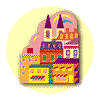









ADAMAS
 Adamas is the haven of Milos, its natural harbour where ships drop anchor. It has a population of about 1,500. It was founded by Cretans who came to the island from Sfakia when Turks quelled the revolution there.
Today, Adamas is the touristic centre of Milos. It has hotel units, guest houses, summer houses, restaurants, tavernas and bars at the service of tourists who have preferred Milos more and more in recent years. In contrast to other Cycladic harbours, Adamas has a big surface area. The same thing happens with its houses, which are quite a distance from each other, without narrow alleyways in between, like the rest of the Cyclades.
One should visit the churches of the Annunciation of the Virgin, Agios Haralambos, and especially Agia Triada (Holy Trinity), which is the island's most notable church. Built in the 17th century, it includes rare Cretan-Byzantine icons and is of Ipirotan style.
Adamas is the haven of Milos, its natural harbour where ships drop anchor. It has a population of about 1,500. It was founded by Cretans who came to the island from Sfakia when Turks quelled the revolution there.
Today, Adamas is the touristic centre of Milos. It has hotel units, guest houses, summer houses, restaurants, tavernas and bars at the service of tourists who have preferred Milos more and more in recent years. In contrast to other Cycladic harbours, Adamas has a big surface area. The same thing happens with its houses, which are quite a distance from each other, without narrow alleyways in between, like the rest of the Cyclades.
One should visit the churches of the Annunciation of the Virgin, Agios Haralambos, and especially Agia Triada (Holy Trinity), which is the island's most notable church. Built in the 17th century, it includes rare Cretan-Byzantine icons and is of Ipirotan style.
 Apollonia, or Pollonia, lies at the north-east edge of Milos, and in recent years it has become an important holiday resort. It took its name from the temple of Apollo which stood near Faros, of Pelekouda.
The ancient city of Filakopi is one of the most significant sights in the area. Excavations have brought to light three successive layers. The first one belongs to the early-Cycladic era, the second one to the
middle-Cycladic era, and the third and largest one must have been built around 1,500 BC.
Another sight is the Cave of Papafragas, next to the archaeological site. It consists of three small caves which were used as pirate hideouts during Byzantine times.
Apollonia, or Pollonia, lies at the north-east edge of Milos, and in recent years it has become an important holiday resort. It took its name from the temple of Apollo which stood near Faros, of Pelekouda.
The ancient city of Filakopi is one of the most significant sights in the area. Excavations have brought to light three successive layers. The first one belongs to the early-Cycladic era, the second one to the
middle-Cycladic era, and the third and largest one must have been built around 1,500 BC.
Another sight is the Cave of Papafragas, next to the archaeological site. It consists of three small caves which were used as pirate hideouts during Byzantine times.
 Plaka is the capital of Milos and is built at the foot of Kastro. It owes its name to the wide spot (plaka), on which the first buildings were constructed. According to one view, the villagers chose this name in honour of the toponymy, where the Milian hero, Andreas Miliotis, was hung by the Turks in Crete.
Most of the island's public services, like the high school, the Lyceum and the Medical Centre, are in town.
Some of the most significant sights in Plaka are the church of Panagia Korfiatissa (19th c.) and the church of Panagia Thalassitra, which is built a few metres before the remains of the castle and has old icons and an excellent wood-carved screen. And finally, there is the church of Panagia Schiniotissa, or Mesa Panagia, which is built inside the castle. What remains from that castle itself, built by the Venetians in the 13th century, is but a few remnants.
Plaka is the capital of Milos and is built at the foot of Kastro. It owes its name to the wide spot (plaka), on which the first buildings were constructed. According to one view, the villagers chose this name in honour of the toponymy, where the Milian hero, Andreas Miliotis, was hung by the Turks in Crete.
Most of the island's public services, like the high school, the Lyceum and the Medical Centre, are in town.
Some of the most significant sights in Plaka are the church of Panagia Korfiatissa (19th c.) and the church of Panagia Thalassitra, which is built a few metres before the remains of the castle and has old icons and an excellent wood-carved screen. And finally, there is the church of Panagia Schiniotissa, or Mesa Panagia, which is built inside the castle. What remains from that castle itself, built by the Venetians in the 13th century, is but a few remnants.
http://www.areianet.gr/infoxenios/
